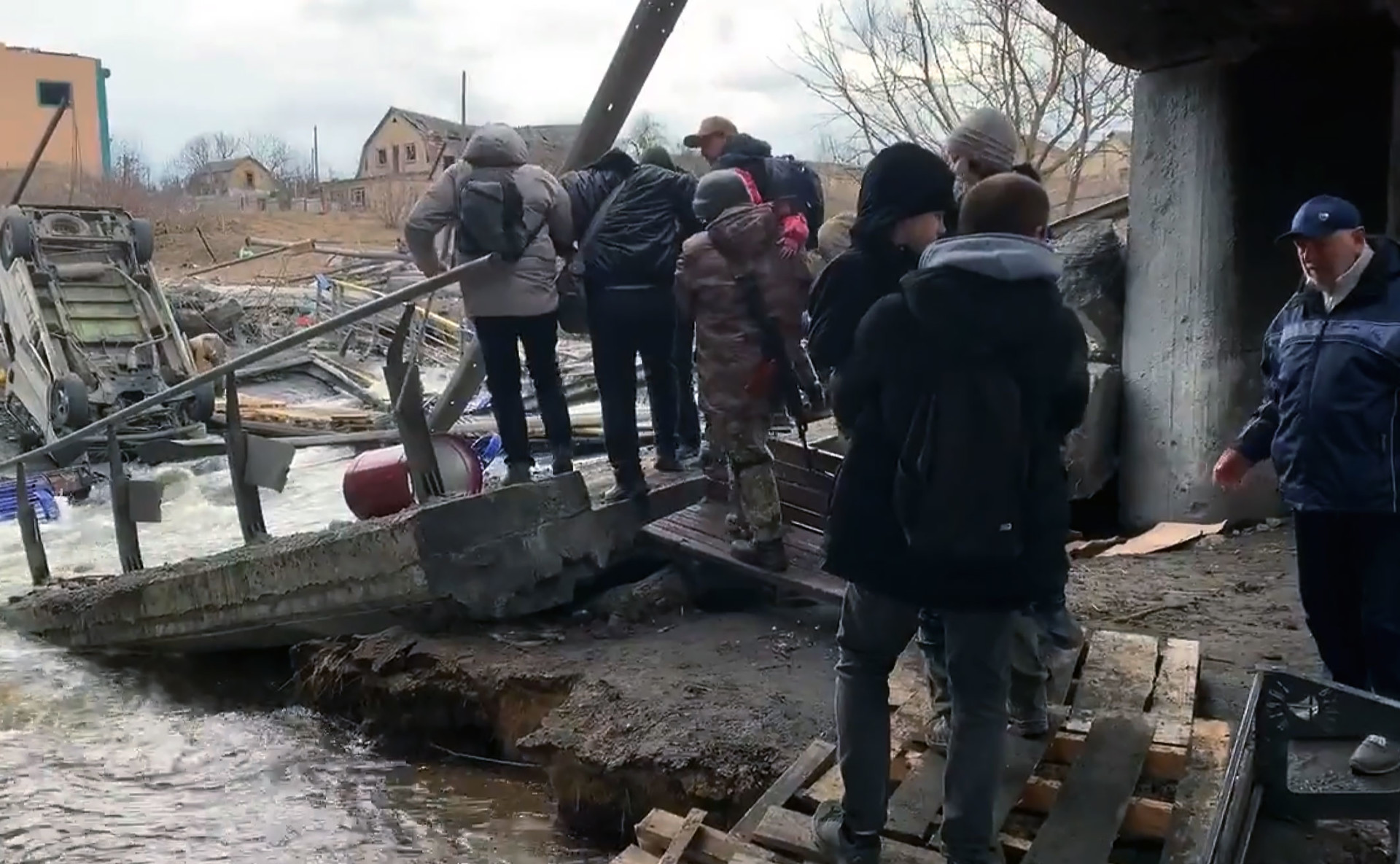Few things in life can prepare you for witnessing human suffering on an industrial scale, and there is no way to prepare yourself to witness what is happening here in Ukraine.
The totalitarian military dictatorship that rules Russia is targeting civilians, and having witnessed it with my own eyes, there is no way to dispute what is taking place in this country.
The testimony of shellshocked civilians pouring out of Irpin, on the northwest outskirts of Kyiv, confirms what is already evident from viewing the devastation wrought on the town bordering Ukraine’s capital city.
The cars abandoned on the destroyed bridge leading south from Irpin toward Kyiv are strewn with bullet holes. White rags hang out of car windows; some even have the word “evacuation” written in large Cyrillic letters making it clear these are civilian vehicles. There can be no mistaking what happened to these people as they tried to flee the town that has been under sustained Russian bombardment for days.
After more than a decade of covering the war in Syria, part of you becomes convinced that you have become numbed to human suffering, but reality hits the moment you see the horror the Russian military is inflicting on innocent people in Ukraine.
As women, children, the elderly and the infirm continue to pour out of Irpin, the difference between the two parties of this conflict could not be clearer. Ukrainian soldiers, territorial defense volunteers and paramedics work throughout the day to evacuate civilians from the besieged town, while Russia bombards the fleeing population with artillery and mortar fire.
The bravery and insanity witnessed on that bridge in Irpin are difficult to put into words. Every few minutes a car will reach the end of the bridge, and civilians, including disabled passengers or very small children, often those who were not able to make it out of the town before the fighting engulfed the area, jump out and start heading down toward the makeshift pontoon made from wooden crates to get to safety across the Bucha River.
The drivers then turn the cars around, weaving their way through dozens of abandoned vehicles, and head back across the front line to transport more victims of the war. To make it across that line once is a miracle. To continue going back into that hell can only be described as selfless heroism or sheer madness.
The body of a man lies on the ground, his face turned toward the concrete. The bicycle he was riding before he died lies mangled behind him, his cellphone out of his pocket. As the living work their way down toward the river crossing with its strong currents in freezing conditions, there is simply no time to deal with the dead.
A nursery, a food warehouse and an Orthodox Church — there is little civilian infrastructure in Irpin that has been spared from Russia’s brutal assault. The people who are fleeing their homes face an uncertain future; they do not know if they will ever be able to go back; they do not know if there will ever be anything to go back to. Russia’s objective is to break Ukrainians’ resolve by targeting civilians and civilian infrastructure. It is the same model they employed in Chechnya and Syria, and it is the same model they will continue to employ until they are defeated militarily.
For our part, we were lucky to have made it to Irpin alive. On our route toward the town, three other journalists and I traveled with our driver along a route we believed to have been safe; other journalists had journeyed along that same road only a day earlier.
However, rather than encountering a Ukrainian military checkpoint, we were instead confronted by the sight of a military unit from Russia’s airborne forces, otherwise known as the VDV. The men wore white armbands and orange-and-black St. George’s ribbons; their BMP-2M marked with a painted “V” was parked in the middle of the road. It had its machine gun pointed directly at our vehicle.
The Russians seemed as bewildered to see us as we them — our car clearly marked with the word “PRESS” in letters fashioned out of yellow gaffer tape. If not for the quick and calm decision-making of our driver, Roman, who slowly turned the vehicle around and drove away before the troops had time to decide to detain us, we may never have made it to Irpin at all.
Days earlier, Sky News’ Stuart Ramsay and his team were ambushed and shot in similar circumstances on a road just outside of Kyiv. Video footage recently published online has shown Russian soldiers clearly targeting civilian vehicles with the intention of killing the passengers.
We will probably never know why we were allowed to turn our vehicle around when so many civilians have been mercilessly targeted by Russian aggression. What we do know after witnessing the carnage in Irpin is that there can be no room for doubt as to what Russia’s military objectives are: to inflict unrestrained violence against the softest of targets, with the intention of destroying Ukraine’s will to resist.
But even amid the devastation on Irpin’s bridge of death, the survivors who made their way past the collection of foreign journalists who stood alongside were still strong enough to share brief jokes with us and one another. Ukraine’s infrastructure may end up shattered and destroyed, but the Ukrainian people continue to show their defiance and steadfastness in the face of unspeakable brutality.
It is unclear how Russian President Vladimir Putin can win a war, even a war fought with relentless barbarism against Ukraine’s innocent population, when those people simply refuse to be broken.



